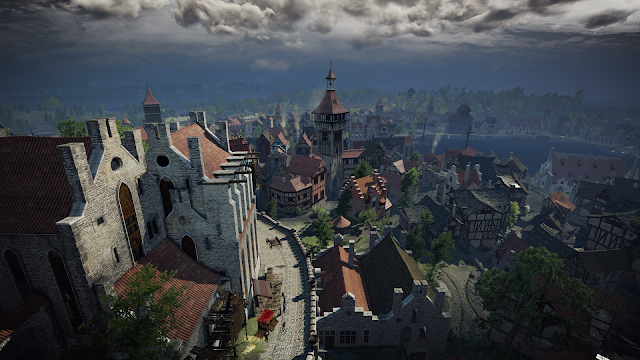Something deep inside of us longs to see beyond the horizon. Staring into the setting sun, we all wonder about the marvels which might be off in the distance. The phenomenon isn’t particular to any people, place, or period: Homer enthralled the ancient Greeks with his tall tales about the return trip from Troy. Jonathan Swift wrote similar stories a few thousand years later. What makes people so curious? In a word: mystery. We can’t be sure what’s over the horizon - and that’s precisely what makes it so alluring.
How many games promise hours of exploration, but never produce a meaningful experience? What makes exploration fun is the delightful sense of discovery which comes with unexpectedly finding something. It’s this
ah-hah! moment that keeps players plodding from place to place when they should really be doing something more pressing like buying birthday gifts for their kids or filing tax returns. (Sure, these things come at the same time every year, but it’s never too late to procrastinate). Remove this giddy thrill from a game and even the grandest open world will still seem empty. There’s no reason to explore if you can’t discover. The best games in other words keep us wondering what we’ll find as we traverse their worlds. They maintain the mystery right up until the very last moment.
How have recent games dealt with exploration? Giving players different levels of knowledge about the game world, there have really been only three different approaches. These are characterized by
Watch Dogs 2,
The Witcher 3, and
Breath of the Wild.
The map in
Watch Dogs 2 becomes an ocean of pegs and points within a few hours of playtime. The game has an icon for just about everything: activities, challenges, locations, and even certain item classes. You have dozens of dots adorning your minimap at any given moment. While some of these are revealed from the outset, most only become visible as you traverse the game world. This feature is problematic because points of interest will pop onto your map when you’re not actually looking for them. You’ll probably never notice that you’ve ‘discovered’ most of them before it’s too late. Bring up the map after speeding through any part of San Francisco in the course of a quest and you’ll find a few more clothing shops and car dealerships than used to be there. The city feels eerily empty because you never actually find anything on your own. You’re always chasing after known values.
 |
| Watch Dogs 2 features a massive open world |
 |
| Watch Dogs 2 finds most of its points of interest for you |
The Witcher 3 takes a very different approach to exploration. You’re given pretty much total knowledge about the game world upfront, but the information comes with a catch: you won’t find out what something is until you come across it. Your map just fills with a series of question marks whenever you check out the local bulletin board. These markers reveal nothing about the game’s points of interest apart from their location. But that’s where things get interesting. Take a look at where they’re situated and you’ll find that only a few of them are in parts of the game world that you would normally traverse. The most efficient path between cutscene locations rarely comes close to them. This preserves the
ah-hah! moment of discovery by ensuring that players are genuinely motivated to find the game’s points of interest, but still in the dark as to what they actually are.
The Witcher 3 maintains the mystery for as long as possible.
 |
| You have to go out of your way to find The Witcher 3's points of interest |
 |
| The Witcher 3 keeps you in the dark about what you'll find at its map markers |
Watch Dogs 2 and
The Witcher 3 rely on map markers to attract your attention to their points of interest.
Breath of the Wild on the other hand makes you hunt around for them.
There are tons of interesting things to be found in
Breath of the Wild, but only a few of them are explicitly marked. Nothing on your map is revealed when you unlock a Sheikah Tower apart from the local topography. This means that finding things in
Breath of the Wild involves thoroughly investigating the game world. You’ll end up heavily relying on your binoculars. Luck is occasionally a factor, but you normally have to scrutinize your surroundings to find anything. The good stuff will always be off the beaten path, too. This creates a truly satisfying sense of discovery whenever you come across a point of interest. Words can’t describe how it feels to spot the orange glimmer of a Shrine as you peek into a precipice or crest a mountaintop. It’s definitely one of those
ah-hah! moments. You’d be doing yourself a disservice by looking up the location online.
 |
| Breath of the Wild makes you go out and find things the old fashioned way |
 |
| You have to scour the terrain to find Breath of the Wild's points of interest |
There’s something truly magical about that
ah-hah! moment of discovery which fades away fast in the face of known values. Exploration is pretty pointless when you know exactly what you’ll find.
The approach to exploration in
Watch Dogs 2 takes most of the mystery out of San Francisco. The game’s gorgeous open world feels empty in comparison to places like the Northern Kingdoms or Hyrule because you’re never allowed to actually discover anything. Putting all of the information about its world at your fingertips, the game simply offers you a list of places to go, things to do, and stuff to see. There’s nothing wrong with this, but it sucks the fun out of exploration by removing the pleasure of discovery. Why not simply hold a few things back instead of putting it all on display?









